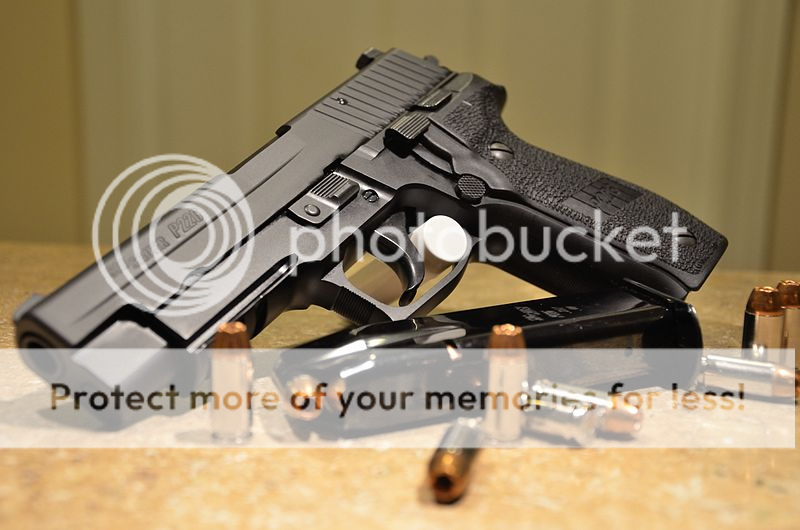
Weapon Name- P226
Round Type- .40 S&W
Over-all length- 196 mm (7.7 in), 38.1 mm (1.50 in), 140 mm (5.5 in)
Barrel length- 112 mm (4.4 in)
Weight- 964 g (34.0 oz) (w/ magazine)
Rate of Fire- Semi-automatic
Feed Mechanism- Detachable Box Magazine
Round Capacity- 13, 15
Effective Range- 50 meters
Range- 100 meters
Accuracy- 4 MOA
Accessories- Picatinny Rails
Quick switch firing mechanism- N/A
Scope/Sights- Picatinny Rails
Muzzle Velocity- 320 m/s
Firing System- P226
Miscellaneous/electronic information- Essentially the P226.
Basic Information
Essentially the P226, with safeties similiar to the 1911, using caseless rounds, and a cobalt chrome barrel. The weapon uses a polygonal cobalt chrome "flow formed" 6 groove (1 in 16 in) (1 complete turn in 16 inches / 406mm) right hand turn barrel; the barrel is made of an alloy that contains more than 50 percent cobalt. The barrel is roughly 13% heavier than standard steel barrels, but is more erosion and corrosion-resistant and is designed to retain high strength during long-term exposure to high temperatures. Cobalt alloys are frequently used in the aerospace industry, such as the hot-gas section of turbine engines. A proof of concept M240 7.62mm x 51mm NATO barrel, in practice, had 24,000 rounds test-fired through it, causing it to reach temperatures of 1,100 degrees, without failure. A steel barrel would have failed under such treatment.
The P226, like the other members of the SIG Classic family, operates by the locked breech short-recoil method pioneered by John Browning. On firing, the slide and barrel are locked together for a few millimeters of rearward movement, after which the barrel is cammed down at the rear. By this time the bullet has left the barrel and the pressure has dropped to safe levels, whereupon the slide completes the rearward stroke, ejecting the spent cartridge. The recoil spring then propels the slide forward, stripping a round from the magazine and in the last few millimeters of forward movement the barrel is cammed upwards, locking the slide and barrel together again.
Instead of the locking lugs and recesses milled into the barrel and slide of other Browning-type weapons (such as the Colt M1911A1, Browning Hi-Power and CZ 75), the P226 locks the barrel and slide together using an enlarged breech section of the barrel locking into the ejection port. This modified system, which was devised by SIG based on Charles Petter's Modèle 1935A pistol and their own SIG P210, has no functional disadvantages compared to the original system, and has since been copied by numerous firearm manufacturers.
The slide of the pre-1996 P226 was a heavy gauge, mill finished sheet metal stamping with a welded on nose section incorporating an internal barrel bushing. The breech block portion was a machined insert attached to the slide by means of brazing and a roll pin visible from either side. Since 1996, production has shifted to CNC machining and the slide is now milled from a single piece of stainless steel. Therefore the current standard P226 has a black anodized, stainless steel slide. This resulted in a stronger slide, which was necessary to chamber the more powerful .40 S&W and .357 SIG cartridges.[citation needed] The frame of most models is made from hard anodized aluminum alloy.
The standard SIG P226 incorporates a decocking lever on the left side of the frame above the magazine release button. In chambering or firing a round, the actuation of the slide automatically cocks the hammer. By using the decocking lever, the hammer can be de-cocked without actuating the firing pin block, making it impossible to accidentally fire the weapon by using the decocking lever. Furthermore, using the decocking lever makes the weapon "drop safe", which means the firing pin will be blocked from striking a loaded round unless the trigger is pulled. Pulling the trigger and slowly lowering the hammer does not make the weapon "drop safe", and can result in an accidental discharge if sufficient force is applied to the hammer. Properly decocked, the pistol can be holstered safely and can be fired in double action mode by simply pulling the trigger. The SIG P226 has no manual safety.
The weapon is based off of the standard P226, although it uses a safety similiar to the 1911. This safety incorporates the back safety and safeties similiar to the 1911, is not double action, and instead a single action weapon.
The .40 S&W combines a blend of power and volume of fire by being small enough to allow 13-15 round magazines, but powerful enough to provide a ballistic advantage over the 9mm. Not quite at the level of a .45 ACP, but close, the 11.7 gram round at approximately 330 m/s is still sub-sonic and extremely powerful, yet allows for the use of a larger capacity magazine (13 or 15 over 7 or 8 ) over the .45 ACP. The .40 S&W was originally developed from the 10mm auto, a round designed to replace the .45 ACP by having a larger volume of rounds per magazine and additionally being more powerful. While more powerful, at nearly twice the energy, and with a much flatter trajectory and greatly increased range, the weapon was considered too powerful in the hands of some people with small pistols and thus the .40 was chosen instead. While not as powerful, and not the ballistic equal of the .45, it blends a medium exchange of 9mm and .45 ACP, almost reaching both in terms of power and magazine capacity.

